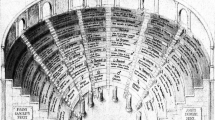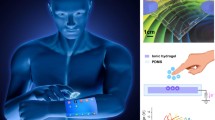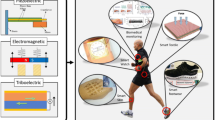Abstract
This paper presents a development history of a wearable, scalable vibrotactile stimulus delivery system. This history has followed a path from desktop-based, fully wired systems, through hybrid approaches consisting of a wireless connection from the host computer to a body-worn control box and wires to each tactor, to a completely wireless system employing Bluetooth technology to connect directly from the host to each individual tactor unit. Applications for such a system include delivering vibrotactile contact cues to users of virtual environments, providing directional cues in order to increase situational awareness in both real and virtual environments, and for general information display in wearable contexts. Through empirical study, we show that even a simple configuration, such as eight tactors arrayed around the torso, can be effective in increasing situational awareness in a building-clearing task, compared to users who perform the same task without the added cues.

















Similar content being viewed by others
References
Howe RD, Kontarinis DA, Peine WJ (1995) Shape memory alloy actuator controller design for tactile displays. In: Proceedings of the 34th IEEE Conference on Decision and Control, vol 4,pp 540–3544
Akamatsu M, Sato S (1994) A multi-modal mouse with tactile and force feedback. Int J Hum Comput Stud 40:443–453
Cholewiak RW, Brill JC, Schwab A (2004) Vibrotactile localization on the abdomen: effects of place and space. Percept Psychophys 66(6):970–987
Tan H, Lu I, Pentland A (1997) The chair as a novel haptic user interface. In: Proceedings of the workshop on perceptual user interfaces. Banff, Alberta, pp 56–57
Rupert A (2000) An instrumentation solution for reducing spatial disorientation mishaps. IEEE Eng Med Biol 19(2):71–80
Erp JBF van, Veen HAHC van (2003) A multi-purpose tactile vest for astronauts in the international space station. Proc Eurohaptics, Trinity college, Dublin, Ireland, pp 405–408
Brooks FP Jr, Ouh-Young M, Batter JJ, Kilpatrick PJ (1990) Project GROPE: haptic displays for scientific visualization, Proc SIGGRAPH, Comput Graph 24(4):177–185
Tan H, Lim A, Traylor R (2000) A psychophysical study of sensory saltation with an open response paradigm. In: Proceedings of the 9th international sympoisum on haptic interfaces for virtual environment and teleoperator systems, pp 1109–1115
Lindeman RW, Templeman JN, Sibert JL, Cutler JR (2002) Handling of virtual contact in immersive virtual environments: beyond visuals. Virtual Real 6(3):130–139
Choi S, Tan HZ (2003) An experimental study of perceived instability during haptic texture rendering: effects of collision detection algorithm. In: Proceedings of the 11th international sympoisum on haptic interfaces for virtual environment and teleoperator systems, pp 197–204
Lindeman RW, Sibert JL, Lathan CE, Vice JM (2004) The design and deployment of a wearable vibrotactile feedback system. In: Proceedings of the 8th IEEE international sympoisum on wearable computers. Arlington, VA, pp 56–59
Amemiya T, Yamashita J, Hirota K, Hirose M (2004) Virtual leading blocks for the deaf-blind: a real-time way-finder by verbal-nonverbal hybrid interface and high-density RFID tag space. Proc IEEE Virtual Real 165–172
Chua PT, Crivella R, Daly B, Hu N, Schaaf R, Ventura D, Camill T, Hodgins J, Pausch R (2003) Training for physical tasks in virtual environments: Tai Chi. Proc IEEE Virtual Real 87–94
Yano H, Ogi T, Hirose M (1998) Development of haptic suit for whole human body using vibrators. Trans Virtual Real Soc Jpn 3(3):141–147
Tan HZ, Gray R, Young JJ, Traylor R (2003) A haptic back display for attentional and directional cueing. Haptics-e 3(1):http://www.haptics-e.org
Lindeman RW, Cutler JR (2003) Controller design for a wearable, near-field haptic display. In: Proceedings of the 11th sympoisum on haptic interfaces for virtual environment and teleoperator systems, pp 397–403
Jones LA, Nakamura M, Lockyer B (2004) Development of a tactile vest. In: Proceedings of the 12th sympoisum on haptic interfaces for virtual environment and teleoperator systems, pp 82–89
Gemperle F, Ota N, Siewiorek D (2001) Design of a wearable tactile display. In: Proceedings of the international sympoisum on wearable computers, pp 5–12
Cohen J, Niwa M, Lindeman RW, Noma H, Yanagida Y, Hosaka K (2005) A closed-loop tactor frequency control system for vibrotactile feedback. Extended Abstracts, ACM CHI 2005, Portland, Oregon, pp 1296–1299
Lindeman RW, Page R, Yanagida Y, Sibert JL (2004) Towards full-body haptic feedback: the design and deployment of a spatialized vibrotactile feedback system. Proceedings of ACM Virtual Reality Software and Technology (VRST) 2004. Hong Kong, China, pp 146–149
Toney A, Dunne L, Thomas B, Ashdown S (2003) A shoulder pad insert vibrotactile display. In: Proceedings of the international sympoisum on wearable computers, pp 35–44
Lindeman RW, Sibert JL, Mendez-Mendez E, Patil S, Phifer D (2005) Effectiveness of directional vibrotactile cuing on a building-clearing task. In: Proceedings of ACM CHI 2005. Portland, Oregon, pp 271–280
Erp JBF van (2000) Direction estimation with vibro-tactile stimuli presented to the torso: a search for a tactile egocentre. In: TNO-Report TM-00-B012. TNO Human Factors, Soesterberg, The Netherlands
Niwa M, Yanagida Y, Noma H, Hosaka K, Kume Y (2004) Vibrotactile apparent movement by DC motors and voice-coil tactors. In: Proceedings of the 14th International Conference on Artificial Reality and Telexistence (ICAT), pp 126–131
Acknowledgements
This research was supported in part by the National Institute of Information and Communications Technology in Japan.
Author information
Authors and Affiliations
Corresponding author
Rights and permissions
About this article
Cite this article
Lindeman, R.W., Yanagida, Y., Noma, H. et al. Wearable vibrotactile systems for virtual contact and information display. Virtual Reality 9, 203–213 (2006). https://doi.org/10.1007/s10055-005-0010-6
Received:
Accepted:
Published:
Issue Date:
DOI: https://doi.org/10.1007/s10055-005-0010-6




